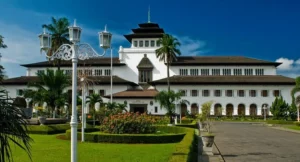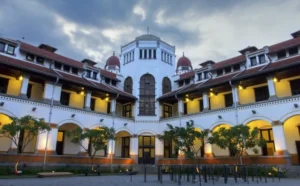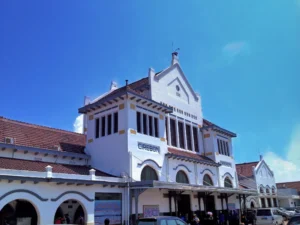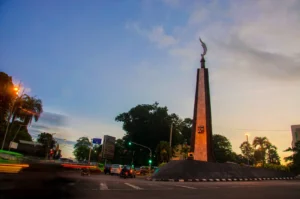Welcome to Java Island, the flagship tourist destination in Indonesia, which captivates with its natural richness, cultural diversity, and exceptional historical heritage. As the most populous island in Indonesia, Java draws the attention of travelers with an extraordinary tourist experience. By exploring the beauty of Java Island, the Java Island Map 2024 serves as a valuable guide to ensure that your journey remains unforgettable.
As you navigate through this map, you will discover amazing destinations scattered throughout the island, including fascinating exotic beaches and historical sites that provide an in-depth insight into the cultural and historical wealth of this island. Plan your trip carefully based on the Java Island Map 2024 and uncover the wonders awaiting you in each city and region.
With the Java Island map as your primary guide, your journey begins by exploring Jakarta, a dynamic metropolis, then continues to Bandung, a unique creative and gastronomic city. Next, the map guides you through the cultural and educational center of Yogyakarta, the eastern gateway of Surabaya, and the natural charm of Malang. Detailing interesting destinations such as Semarang, Cirebon, Bogor, Puncak, Solo, Karimun Jawa, and Anyer, the Java Island Map 2024 becomes the key to discovering the charms and peculiarities of each place. By understanding this map well, you can plan an optimal trip and ensure a satisfying holiday experience on this captivating island of Java.
Java Island Map Image
source: bp.blogspot.com
History of Java Island
Java Island is part of the Greater Sunda archipelago and the Sunda Shelf, which, in an earlier era before the melting of ice, constituted the southeastern end of the Asian continent. Fossils of Homo erectus, commonly known as the Man of Java, have been discovered along the banks of the Bengawan Solo River, dating back 1.7 million years. The prehistoric site of Sangiran in Java is a significant discovery, with megalithic structures such as menhirs, dolmens, stone tables, and stepped pyramids called Punden Berundak found in various locations on Java Island.
Punden Berundak and menhirs have been discovered at megalithic sites in Paguyangan, Cisolok, and Gunung Padang, in West Java. The megalithic site of Cipari in West Java shows monolithic structures, stone terraces, and sarcophagi. These Punden Berundak are considered indigenous structures of the archipelago and served as the basis for the construction of temples during the period of Hindu-Buddhist kingdoms in the archipelago, following the influence of Hindu-Buddhist civilization from India. From around the 4th century BCE to the 1st or 5th century CE, the Buni culture emerged on the northwest coast of Java, becoming the predecessor of the Tarumanagara kingdom.
Java Island, fertile and receiving abundant rainfall, facilitated rice cultivation in wet areas, stimulating the development of complex collaborations between villages. From these village alliances, small kingdoms emerged. Geographical features such as volcanic mountains and plateaus led to a relative isolation of inland regions and their inhabitants from external influences. Before the advent of Islamic states and European colonialism, rivers were the main means of communication, especially the Brantas and Bengawan Solo, which served as long-distance links.
It is estimated that a communication system including a road network, permanent bridges, and toll stations had been established in Java by at least the mid-17th century. Local rulers controlled these routes, and heavy rains could often hinder travel. At that time, communications among the people of Java were considered difficult.
The emergence of civilization in Java is often associated with the arrival of Aji Saka in 78 CE. However, the history of Aji Saka is objected to by other historical sources. The writings of Valmiki’s Ramayana, dating from around 500 BCE, mention that Java already had a well-established government organization well before the story of Aji Saka. According to the Ming Shǐ, historical Chinese records, the kingdom of Java was founded in 65 BCE, 143 years before the start of Aji Saka’s story.
The story of Aji Saka is considered part of the myth of New Java and has not yet found relevance in ancient Java texts. This story recounts events in the kingdom of Medang Kamulan in the past, describing the influence of Indian culture on Java. It shows the division of the Java kingdom into two parts: one maintaining Hindu traditions and the other adopting Hindu traditions after 78 CE.
Cities on Java Island
1.Jakarta: Dynamic Metropolis
source: travelmarbles.com
In planning your adventure on Java Island, there is nothing more delightful than visiting Jakarta, the vibrant capital of Indonesia. With the guidance of the Java Island Map 2024, travelers can explore Jakarta, where the bustle of urban life harmoniously blends with a rich historical heritage. An exciting starting point is the Monas, a majestic symbol of national height and pride. Detailing each step using the Java Island Map, tourists can explore the Merdeka Palace, a silent witness to Indonesia’s history.
Furthermore, the historic old town offers delicious Betawi cuisine while admiring the beauty of colonial architecture. It is wise to choose your accommodation wisely based on the Java Island Map to ensure comfort and easy access to all attractions around downtown Jakarta. Thus, the adventure in Java begins with confident steps in this colorful capital.
2.Bandung: Creative and Gastronomic City
source: blogkotakita.blogspot.com
Next, the journey to Bandung, a creative city on Java Island, adds a touch of beauty to the Java Island Map. Bandung is famous for its unique design and refreshing artistic atmosphere, creating an unforgettable holiday experience. Explore the Instagrammable cafes of Dago while discovering local crafts at Pasar Baru, which is an integral part of the cultural richness of Java Island.
Don’t forget to savor the specific culinary delights of Bandung, such as batagor and surabi, which are also culinary specialties of Java Island. With the fresh mountain air, Bandung adds a unique touch to the Java Island Map, inviting travelers to enjoy the natural beauty and cultural diversity of the region.
This journey is not only an adventure in Bandung but also contributes to the exploration of the Java Island Map. Bandung, as a strategic destination on Java Island, enriches the traveler’s experience with its natural beauty and cultural richness. By exploring the Instagrammable cafes of Dago and observing local crafts at Pasar Baru, visitors can feel the diversity of creativity that is an integral part of Java Island.
Savoring the culinary specialties of Bandung, such as batagor and surabi, also adds a rewarding taste experience and reinforces the culinary heritage of Java Island. Thus, the journey to Bandung is not limited to creating pleasant memories in this creative city but also illustrates the uniqueness of Java Island on the map of Indonesian tourist destinations.
















